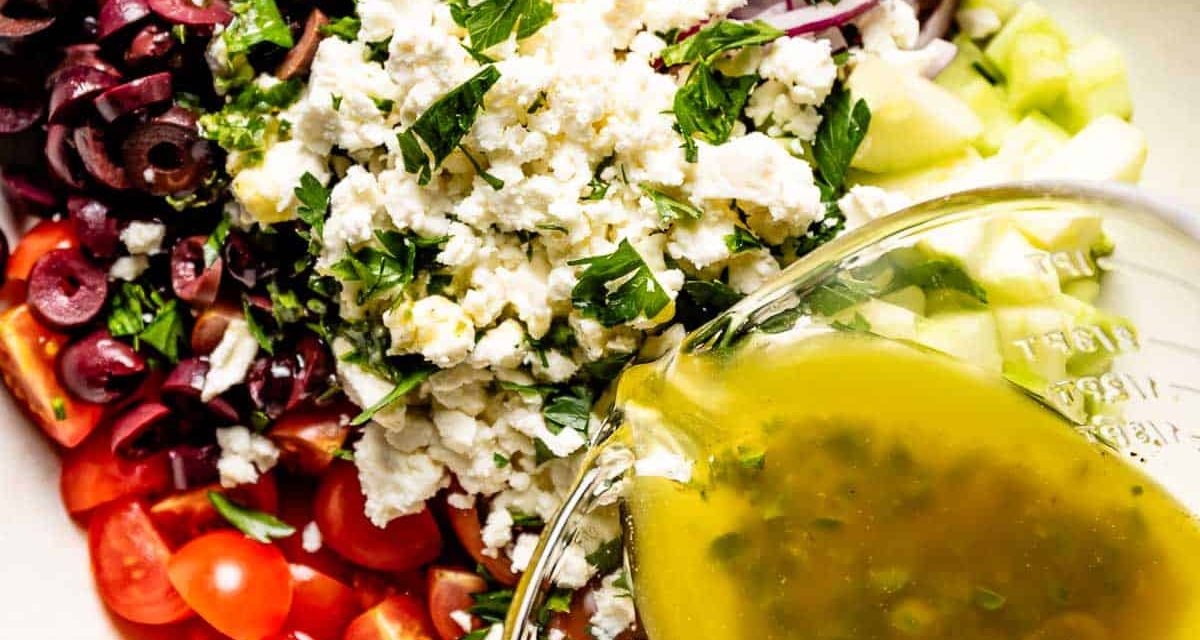Mediterranean Salad Dressing Recipe and History
Mediterranean salad dressing is the essence of freshness — a perfect balance of olive oil, lemon juice, herbs, and garlic that brings life to any dish. This versatile dressing captures the heart of Mediterranean cuisine, emphasizing natural ingredients and vibrant flavors. It’s not just a dressing for salads but a cornerstone of the region’s healthy, flavorful diet that has nourished generations across Greece, Italy, Spain, and beyond.
The History of Mediterranean Salad Dressing
The roots of Mediterranean dressing stretch back thousands of years to ancient civilizations that thrived along the Mediterranean Sea. Olive oil, one of its core ingredients, has been a culinary staple since at least 6000 BC, with archaeological evidence of olive cultivation found in Crete and Syria. The Greeks and Romans considered olive oil a gift from the gods — essential not only for cooking but also for rituals, medicine, and trade.
As trade routes expanded, Mediterranean cooks began combining olive oil with vinegar, lemon juice, and local herbs. The Greeks preferred lemon and oregano, Italians used balsamic and basil, and Middle Eastern cultures favored garlic and mint. Each variation reflected the unique climate, crops, and tastes of its region. Over centuries, these combinations evolved into what we now recognize as the classic Mediterranean dressing — simple, healthful, and deeply satisfying.
Today, Mediterranean salad dressing is loved worldwide for its clean, bright flavor and nutritional benefits. It embodies the Mediterranean diet’s focus on heart-healthy fats, antioxidants, and fresh, seasonal ingredients.
Ingredients
- ½ cup extra-virgin olive oil
- 3 tablespoons red wine vinegar (or lemon juice for a brighter flavor)
- 1 teaspoon Dijon mustard (optional for creaminess and depth)
- 1 clove garlic, finely minced
- 1 teaspoon dried oregano (or 1 tablespoon fresh)
- ½ teaspoon dried basil
- ¼ teaspoon dried thyme
- Salt and freshly cracked black pepper to taste
- Optional: 1 teaspoon honey or maple syrup for sweetness
Instructions
- Combine Ingredients: In a small bowl or jar, whisk together the vinegar (or lemon juice), mustard, minced garlic, and herbs.
- Add Olive Oil: Slowly drizzle in the olive oil while whisking constantly until the dressing emulsifies and thickens slightly.
- Season: Add salt and pepper to taste. Adjust acidity or sweetness depending on your preference.
- Rest and Serve: Let the dressing sit for 10–15 minutes to allow the flavors to blend. Shake or whisk again before serving.
This recipe makes about ¾ cup of dressing and keeps in the refrigerator for up to a week.
Variations
- Greek Style: Add crumbled feta cheese and fresh oregano for a tangy twist.
- Italian Version: Use balsamic vinegar instead of red wine vinegar and add a pinch of garlic powder.
- Herb Lovers’ Mix: Stir in fresh parsley, basil, or mint for extra vibrancy.
- Tahini Mediterranean: Add a spoonful of tahini for a creamy, nutty texture common in Levantine cuisine.
- Citrus Delight: Replace vinegar with a blend of lemon and orange juice for a lighter, fruitier profile.
Nutritional and Cultural Significance
Mediterranean dressing reflects one of the world’s healthiest diets — one praised by nutritionists and scientists alike. Olive oil provides monounsaturated fats that support heart health, while herbs like oregano and thyme offer antioxidants and anti-inflammatory properties. Garlic contributes immune-boosting compounds, and lemon juice or vinegar aids digestion.
In Mediterranean culture, food isn’t just nourishment — it’s community. Dressing salads with olive oil and herbs is a ritual of connection, shared at long tables with family and friends. It represents balance — between indulgence and health, simplicity and sophistication. This approach to food is what has helped Mediterranean countries maintain longevity and wellness for generations.
Serving Suggestions
Mediterranean salad dressing is incredibly versatile. Drizzle it over mixed greens, cucumbers, tomatoes, and red onions for a classic Greek salad. It’s also delicious as a marinade for chicken, fish, or tofu, infusing them with fresh, herbaceous flavor. Use it as a dip for bread, roasted vegetables, or even as a finishing drizzle for grain bowls, couscous, or pasta salads.
For a traditional touch, pair it with feta cheese, kalamata olives, and warm pita bread — a true taste of the Mediterranean coast.
The Legacy of a Timeless Classic
From ancient olive groves to modern kitchens, Mediterranean salad dressing continues to embody health, history, and hospitality. It’s proof that simple ingredients, when combined thoughtfully, can create something truly extraordinary. Whether you’re dressing a salad, marinating proteins, or just savoring it with warm bread, this timeless recipe connects you to thousands of years of culinary wisdom — and the joy of eating well.
References:
- BBC Good Food. (2024). Homemade Mediterranean Salad Dressing Recipes. Retrieved from https://www.bbcgoodfood.com
- Smithsonian Magazine. (2023). The History and Health of the Mediterranean Diet. Retrieved from https://www.smithsonianmag.com
- Food Network. (2024). Classic Greek and Mediterranean Salad Dressings. Retrieved from https://www.foodnetwork.com
- Harvard University Press. (2023). The Olive Tree Legacy: Nutrition, Culture, and Longevity in the Mediterranean. Retrieved from https://www.harvard.com





